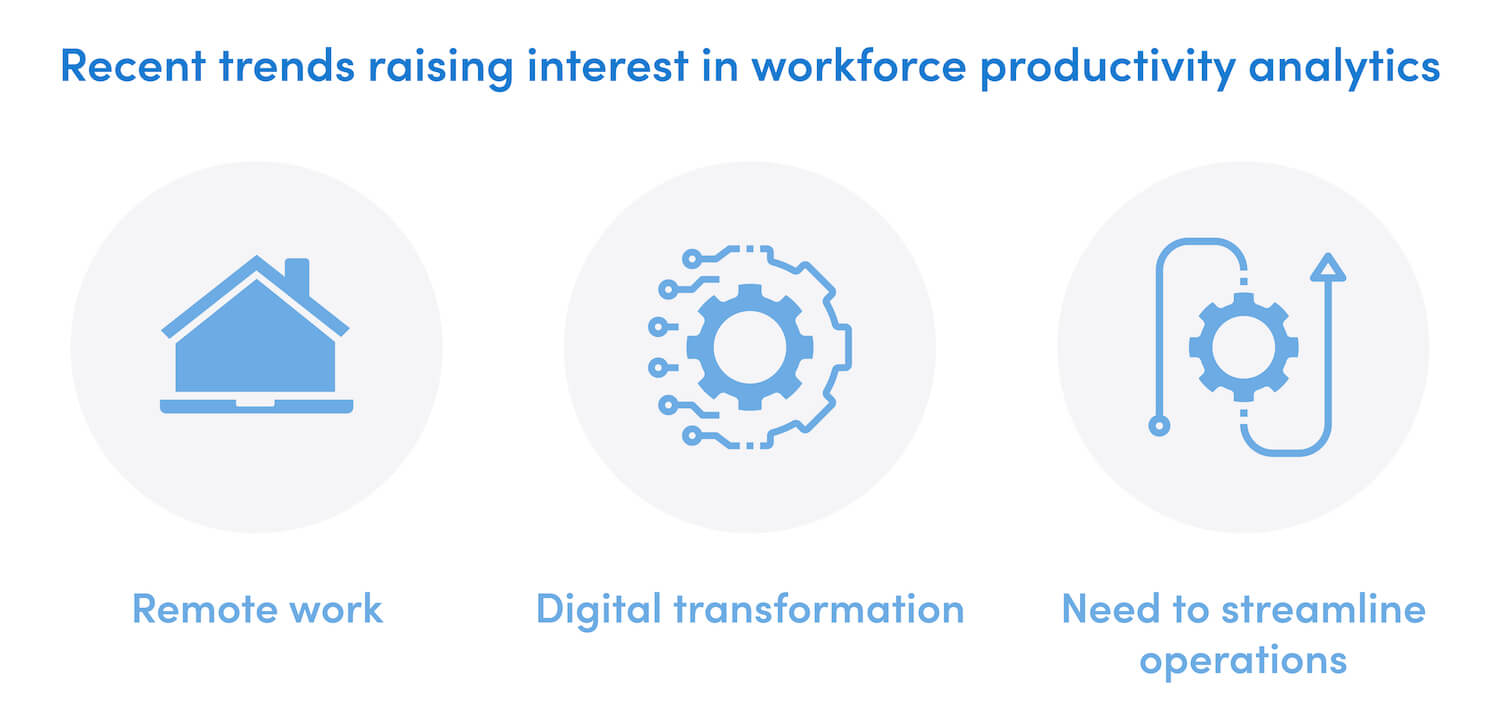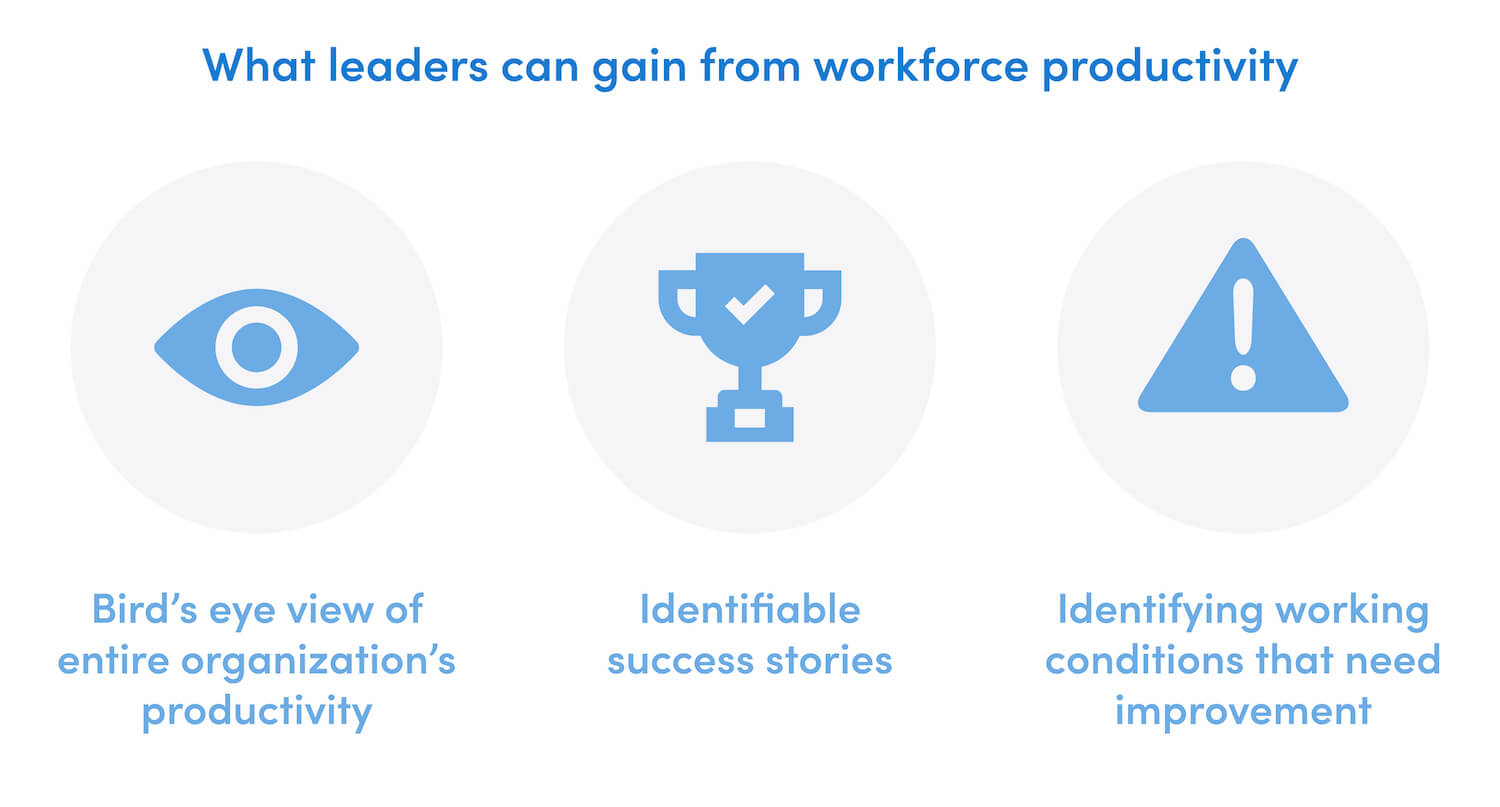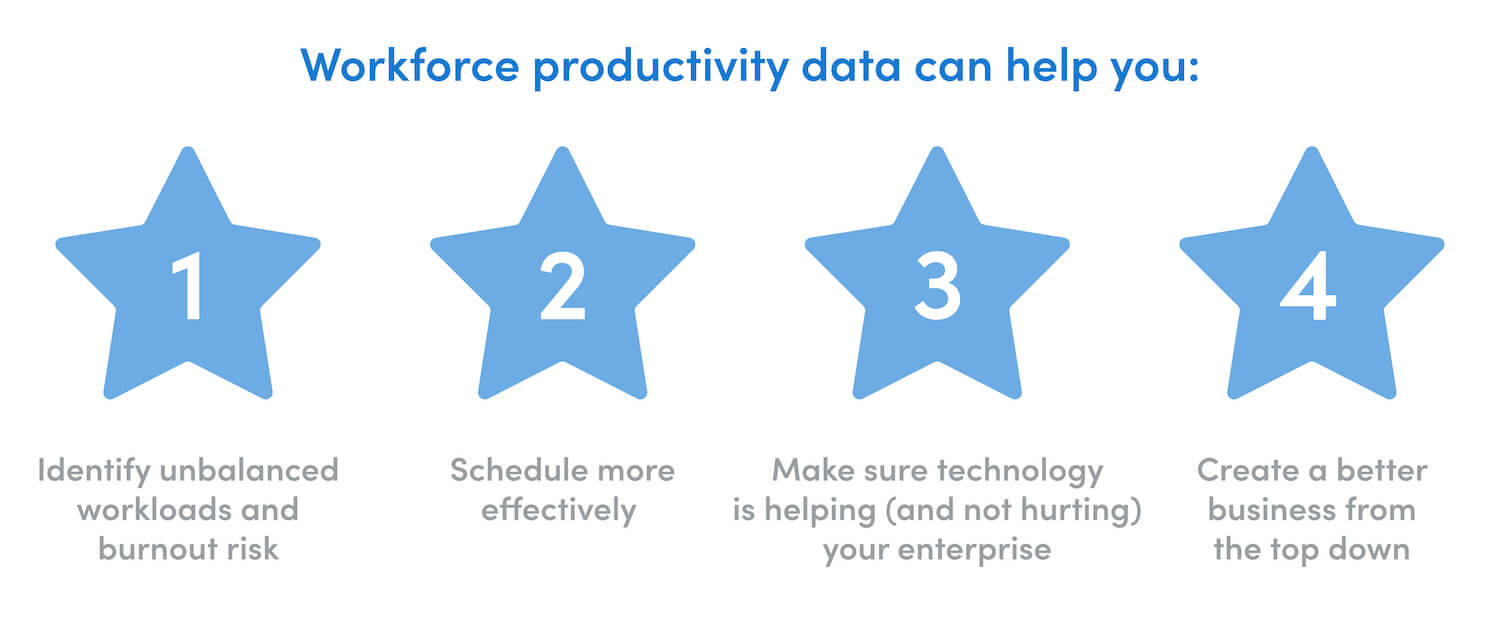Show Hide Topic Menu
- Productivity Management
- How it Works
- Learn how
- Employee Productivity:
A Modern Approach - Productivity Monitoring with Transparency
- 3 Productivity Metrics to Help Your Team Work Wiser
- Productivity Measurement at Your Company
- Tracking Productivity Through Monitoring Software
- Productivity Management for Lasting Change
- Team Productivity Through Workforce Analytics
- What Workforce Productivity Can Teach Leadership
- Productivity vs. Efficiency: Differences and Formulas
- 10 Workplace Productivity Statistics Leaders Should Know
- Employee Productivity:
If you’ve been following along over the last six chapters of this guide to productivity management, it might seem like we’ve covered productivity from every possible angle! We’ve defined the ActivTrak approach to employee productivity, unpacked the importance of transparency in productivity management, explained how to measure productivity, and much more. But we’re not done yet!
It’s time for us to talk about workforce productivity (this one’s for you, leadership).
In this chapter, you’ll read about the rise of workforce productivity analytics and find out what exactly leadership can learn from that data to make a healthier, happier, more productive business environment for their employees.
Where would you like to start?
- Understanding the Rise of Workforce Productivity Analytics
- Why Leaders Should Be Concerned with Workforce Productivity
- What Can Workforce Productivity Data Help You Accomplish?
- Creating a Better Business From the Top Down
Understanding the Rise of Workforce Productivity Analytics
We know we’re seeing a surge of interest in measuring productivity and understanding everything from employees’ time management to their use of specific new technologies, but what’s actually driving that surge? Before we explain that, it’s important to first define the basic function and purpose of workforce productivity to make sure everyone is on the same page.
Workforce productivity is the broadest category of productivity management, focused on all data that is relevant to organizational, team, and employee productivity. Workforce productivity analytics solutions gather employee and team productivity metrics to help executives understand key drivers like time management, technology use, and focus time. By gaining visibility into these drivers — and staying away from basic time tracking that doesn’t give you the full story— business leaders can uncover valuable insights about their organizations that will drive productivity gains and improve business outcomes.
Workforce productivity analytics isn’t a new concept by any means, but we’ve seen a recent surge in interest among leadership due to three recent trends:
The era of remote work
Over the years, the types of flexible work arrangements businesses offer have diversified thanks to telecommuting, flex-time, hot desks, and even the gig economy. Remote work delivers a huge return on investment for the businesses that embrace it effectively. Not only can it increase employee engagement and help employees find a healthy work-life balance, but it also gives businesses a competitive advantage since they get access to larger talent pools and general cost savings.
The speed of digital transformation
The unprecedented pace of digital transformation in the workplace has transformed the way we do work, bringing in new collaboration tools, workflows, and more. Understanding where employees’ time is spent in this digital landscape is essential for making sure you’re making the most of your investments. After all, with all the automation and efficiency gains delivered by deploying new technologies, there are also significant costs to consider. Real-time insights into technology usage empower data-based decision-making that keeps businesses from wasting money on digital solutions that aren’t actually being utilized by a large number of people within the organization.
The need to streamline operations
Every business today is looking for ways to cut unnecessary costs due to economic uncertainty and global competition. One of the best ways to do that is by streamlining inefficient processes, eliminating underutilized resources, and maximizing human resources. Workplace productivity analytics do more than just help you measure productivity. They can also help you identify the best ways to make the most of the resources you have — and help you cut the ones you don’t need.
Why Leaders Should Be Concerned with Workforce Productivity
As a leader you might be wondering, why do I need to be concerned with workforce productivity if my managers and employees are already working on productivity improvement programs? Isn’t that a bit redundant? Good question!
In the same way that productivity looks different for each individual and between teams, you’ll want different things from productivity management based on your role in the organization. For example, an employee might want insight into their own productivity data to learn how to maximize their working hours, while a project manager might use productivity metrics to see whether or not teams are accomplishing their productivity goal benchmarks.
The good news is that workforce productivity encompasses all of that and more — which is why it’s so valuable to leadership. It gives business leaders a bird’s eye view of their entire organization’s productivity, helping them identify success stories, working conditions that need improvement, and everything in between.
But wait! Don’t think that workforce productivity is about oversight. With a secure workforce productivity analytics tool like ActivTrak, executives get access to high-level organizational trends — not just individual activity. This isn’t time tracking or spying. It’s a way to improve workforce management on a large scale.
What Can Workforce Productivity Data Help You Accomplish?
Workforce productivity data helps you answer a number of key questions that are essential to the success of any business environment. Workforce productivity data can help you:
Take a data-driven approach to productivity management
Key Questions: What does employee productivity look like, and how can I improve it? Are employees more productive working remotely or in the office?
Assessing productivity across an entire enterprise is hard, but workforce productivity analytics offers an objective way to measure productivity changes over time and help both employees and teams get the recognition they deserve — all without micromanaging them. Also, workforce productivity data can be used to power workforce planning discussions and departmental hiring plans.
Identify unbalanced workloads and burnout risk
Key Questions: Are any teams at risk of burnout? How do trends differ between newer and older team members?
It’s more important than ever to ensure that employees working in the office and remotely are maintaining a healthy work-life balance and not overworking themselves. Armed with workforce productivity data, executives can advocate for more resources, make changes to the company culture that will support their employees’ engagement and well-being, and inspire change from the top-down.
Schedule more effectively
Key Questions: How can I fully accommodate remote workers in my enterprise?
As more enterprises embrace remote work and investigate hybrid work environments, executives must make sure they’re doing what they can to make remote work a sustainable work option and not a stop-gap measure. Workforce productivity analytics gives leadership the insight needed to make flexible remote work and scheduling arrangements that expand opportunities for employees (and can give the enterprise itself a competitive advantage in the long run).
Make sure technology is helping (and not hurting) your enterprise
Key Questions: Can we consolidate the tools that employees in similar roles are using to simplify workflows and reduce costs? Are unapproved applications being used that introduce compliance risks?
By gaining real-time insight into how teams are spending time on certain applications, you can make data-driven decisions about software usage, stop paying for extraneous apps, and better understand how your teams prefer to get their work done.
Creating a Better Business From the Top Down
With the digitization of work and the adoption of more flexible work schedules, it’s more important than ever for business leaders to understand what their employee productivity actually looks like. Workforce productivity analytics are the best way to gain the high-level insights that empower leaders to make positive changes driven by data.
Pro Tips:
- Even though workforce productivity helps you take a look at your entire enterprise’s productivity levels, “Insight, not oversight” still applies.
- Focus on overall trends instead of individual productivity to make the most of your data.
- Remember that higher productivity begins with better employee well-being.



